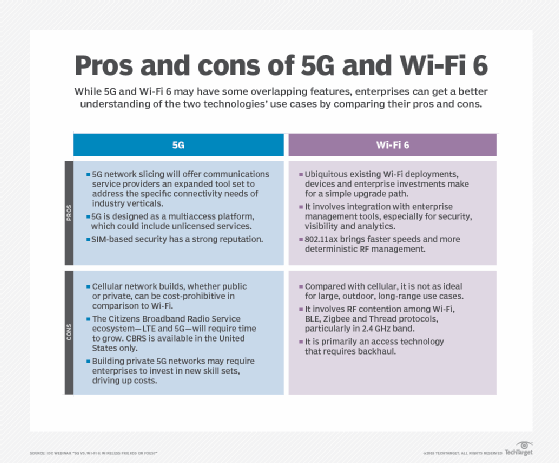Wi-Fi 6 vs. 5G: What's the difference?
Some of the major differences between Wi-Fi 6 and 5G include frequency, authentication, licensing and use cases. But the two technologies can also work well together.
Cellular and wireless technologies evolve every few years, with new generations promising improved features and new use cases. The latest cellular and wireless generations, 5G and Wi-Fi 6, respectively, are no different.
In the wireless world, Wi-Fi 6 aims to stand out from past generations, bringing with it a new generational naming system, increased IoT capabilities and multiuser support. For cellular, 5G introduces network speeds and data rates that cellular technology hasn't seen before, as well as low latency.
While Wi-Fi 6 and 5G differ in several ways, experts suggest the two technologies work well together to support enterprise use cases for IoT, edge computing and remote work.
Defining Wi-Fi 6 and 5G
Wi-Fi 6
Wi-Fi 6, also known as 802.11ax, is a wireless standard defined by IEEE. The Wi-Fi Alliance introduced a new naming system in 2018, aiming to clarify the different Wi-Fi generations using numerical sequences. For example, the previous 802.11n and 802.11ac standards are called Wi-Fi 4 and Wi-Fi 5, respectively.
Wi-Fi 6 builds upon former generations' capabilities but aims to improve efficiency and speeds. Wi-Fi 6 also supports features such as orthogonal frequency-division multiple access (OFDMA) and multiuser multiple input, multiple output (MU-MIMO). Both OFDMA and MU-MIMO enable multiuser support for enhanced performance, capacity and reliability.
5G
Fifth-generation wireless is the latest generation of cellular technology. 5G moves beyond 4G LTE with increased network speeds and reliability. 5G uses higher frequencies than 4G LTE, which means it can transfer data at faster rates and better support real-time communication.
Wi-Fi 6 and 5G share goals to increase bandwidth and network speeds, as well as lower latency. Both aim to improve upon their respective former generations and enhance UX. Yet, the two technologies have key differences that make them complementary to each other and offer alternate connectivity options for organizations.

Differences between Wi-Fi 6 vs. 5G
The key differences between Wi-Fi 6 and 5G include the following:
- Technology type.
- Licensing.
- Frequency.
- Authentication.
- Network security.
- Cost.
- Use cases.
Technology type
Many of the differences between Wi-Fi 6 and 5G stem from the difference between their technology types. 5G is a cellular technology that uses base stations, small cells and radio signals to transfer data and provide connectivity to end-user devices. 5G typically covers a large geographic area. Wi-Fi is a wireless LAN technology that uses routers, access points and radio signals to connect devices in a limited range.
Licensing
Cellular technology is carrier-based, which is also true for 5G technology. This means operators run cellular networks on licensed spectrum bands, which exist to prevent interference between connected devices. In contrast, Wi-Fi operates in unlicensed bands that don't require permission to use.
However, 5G differs from previous cellular generations in this regard and operates in both licensed and unlicensed bands. This could create interference between 5G and Wi-Fi 6 signals near one another and requires extra planning in deployments to avoid interference.
Frequency
5G operators use different frequency bands for their mobile networks, such as 600 MHz, 800 MHz and millimeter wave, which operates between 30 GHz and 300 GHz. Meanwhile, Wi-Fi 6 operates in unlicensed spectrum at 2.4 GHz and 5 GHz. Wi-Fi 6E, an extension of Wi-Fi 6, operates at 6 GHz.
Authentication
While Wi-Fi technology's unlicensed bands don't require permission to use, access to the Wi-Fi network itself does. To access a Wi-Fi network, users typically require a service set identifier -- or network name -- and password. In addition, Wi-Fi 6 introduces a new authentication type called Simultaneous Authentication of Equals for added protection against bad actors.
Cellular networks don't have the same authentication requirements as Wi-Fi networks, so it's simple and easy for connected devices to gain access. However, 5G also uses several authentication types, which include 5G Authentication and Key Agreement, Extensible Authentication Protocol-AKA and EAP-Transport Layer Security to bolster 5G network security.
Network security
Security has been a major 5G concern, due to potentially high costs to secure 5G networks and increased vulnerability concerns. However, 5G introduces several security concepts, including security anchor functions, subscription permanent identifiers and subscription concealed identifiers. These functions enable seamless and secure device reauthentication as a connected device travels between networks, which former cellular generations couldn't guarantee.
Wi-Fi network security is historically easier to guarantee for devices than cellular networks, but Wi-Fi 6 aims to increase this still. Wi-Fi Protected Access 3 (WPA3) supports Wi-Fi 6 security. WPA3 bolsters authentication security and encryption, while also improving upon the shortcoming of its predecessor, WPA2.
Cost
Wi-Fi is typically cheaper to build and use. Unlicensed spectrum doesn't require license fees to use, and Wi-Fi devices are typically more affordable than other networking equipment. 5G offers high-speed connectivity but for higher prices. Most operators have to build their 5G infrastructure from the ground up, which requires heavy investments in equipment and components. They also have to purchase the spectrum to use in their mobile networks.
Use cases
Where and how organizations deploy cellular and Wi-Fi technology are other key differences between Wi-Fi 6 and 5G. Traditionally, Wi-Fi is better suited to indoor wireless coverage, and Wi-Fi 6 maintains this. Other Wi-Fi 6 use cases include increased support for IoT-connected devices and high-density wireless service for locations such as stadiums and sports venues.
As for cellular, 5G is better suited to outdoor use cases, such as autonomous vehicle support. 5G also supports mobile backhaul, fixed wireless access, satellite pairing and edge computing use cases. Organizations that use 4G LTE for backhaul use cases can transition to 5G to improve that connectivity, as well as bring cellular into the fixed wireless space.

Wi-Fi 6, 5G as complements rather than competitors
Despite the differences between Wi-Fi 6 and 5G, the two technologies pair well together. Businesses should focus more on how Wi-Fi 6 and 5G cooperate rather than which technology is better. More importantly, users likely won't care which technology they use as long as their connection is reliable.
Interoperability between Wi-Fi and 5G networks could provide seamless connectivity for users as they move between networks. Connected devices, such as smartphones and laptops, now support both technologies.
Together, Wi-Fi 6 and 5G can enable the success of network innovations, such as IoT growth and edge computing. They can also better support remote workforces and bolster overall network connectivity with speed, reliability and flexibility.
Editor's note: This article was originally published by Michaela Goss and updated by editors to reflect industry changes and improve reader experience.






